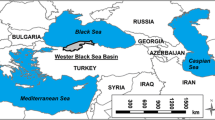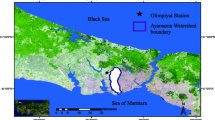Abstract
This study aims to figure out the changes in extreme precipitation events and precipitation-induced maximum flows due to climate change in the Eastern Black Sea Region of Turkey. The Spearman's rho test was applied to the annual maximum daily precipitation and daily flow data to examine the temporal variation. The test results were interpreted at the 95% confidence interval, and no trend was detected. The annual maximum of daily precipitation projections of the RCP4.5 and RCP8.5 scenarios obtained at a resolution of 10 km2 by downscaling from the MPI-ES-MR global climate model was used for statistical modeling of the projection period. According to the RCP 4.5 scenario, the 24-h maximum precipitation for the projection period increased by 20–46% for the 100-year return period compared to the observation period in Trabzon, Rize, Bayburt, and Artvin meteorological stations. On the other hand, there was a decrease between 12 and 42% in Gümüşhane, Giresun, and Ordu stations. According to the RCP8.5 scenario, the change in the 100-year return level between the observation and projection periods was 46% for all stations except for Gümüshane, with a decrease of 8%.
Access provided by Autonomous University of Puebla. Download conference paper PDF
Similar content being viewed by others
Keywords
- Climate change scenario
- East black sea
- Generalized extreme value distribution
- Maximum flow
- Extreme precipitation
1 Introduction
Because climate change and variability can occur at any time and place, climate studies can be conducted for both the present and future. However, climatic parameters must be appropriately monitored to achieve climate studies for the current situation, and their spatial and temporal changes must be recorded.
Climate models are necessary tools to conduct future climate investigations. However, the data of global models spans such a wide area. This results in low-resolution problems. Additionally, it would be inappropriate to utilize them in elaborative investigations. As a result, for studies over smaller areas, data from the global climate model are used as input data to the regional climate model, and data of high resolution are generated for smaller areas (Demircan et al., 2017). For example, daily precipitation estimates obtained from the General Directorate of Water Management of Turkey were downscaled data of the MPI-ES-MR global climate model's RCP4.5 and RCP8.5 scenarios with a resolution of 10 km2.
The study aims to figure out the changes in extreme precipitation events and precipitation-induced maximum flows in the Eastern Black Sea Region of Turkey.
2 Materials and Methods
2.1 Study Area and Data
The study area, the Eastern Black Sea Region, is the wettest region of Turkey. It rains throughout the year, with the most precipitation in the autumn and the least in the spring. The region is mountainous. Mountains rise just after the coast, stretch out in parallel with the Black Sea, and the range of mountains increases toward the inland (https://iklimler.com/karadeniz-iklimi-nedir-nerelerde-gorulur/).
The analyses were carried out by utilizing data from the Eastern Black Sea Region's annual maximum flow related to floods and the annual maximum daily precipitation. Maximum flow data were obtained from the State Hydraulic Works, natural flows of streamflow gauging stations, and data records dating back at least 30 years. In addition, annual maximum daily precipitation data were obtained from the meteorological stations of the Turkish State Meteorological Service for the observation period of 1970 to 2019, MPI-ES-MR global climate model RCP4.5 and RCP8.5 scenarios, and annual maximum daily precipitation for the future period covering years 2015–2099.
2.2 Spearman's Rho Test
Spearman's rho test is commonly used to measure dependence between two variables. This test is nonparametric and also known as the ranking method (Kalaycı & Kahya, 1998). When the number of observations exceeds 30, the Spearman correlation approaches the normal distribution. As a result, the standard normal probability distribution table can be used by subtracting the Spearman correlation from the normal distribution test statistic. The following equations represent the Spearman correlation (ρ) and normal distribution test statistic (Z).
Suppose the calculated z value is greater than the tabulated za value at a corresponding significance level in the normal probability distribution table. In that case, the null hypothesis H0 is rejected to conclude that a trend exists (Spearman, 1904).
2.3 Generalized Extreme Distribution (GEV)
The GEV distribution is used to model the extreme value time series statistically. It is commonly applied to extreme hydrologic time series such as flood maxima, extreme precipitation, temperature, and wind. It has three distinct parameters: α, the scale parameter, λ, the location parameter, and, β, the shape parameter. The probability distribution function of the GEV is as follows:
If the parameter has values close to 1, EV III has a high similarity to the Gumbel distribution; if it has values close to −1, EV II has a high similarity to the Gumbel distribution (Bayazıt & Önöz, 2008).
Various approaches, such as maximum likelihood (ML), MCMC, moments, and L-moments, are used to estimate the distribution parameters. The stationary GEV model and the ML method were employed here for parameter estimation (Gilleland & Katz, 2016).
3 Results
The Spearman rho test was used to analyze the trend of 8 streamflow gauging stations in the Eastern Black Sea Region with a natural flow and precipitation time series, data spanning at least 30 years. As a result, no trend was found in the maximum annual flows and the maximum precipitation time series at the 95% confidence level.
Annual maximum daily precipitation of the 2, 5, 10, 25, 50, and 100-year return periods of RCP4.5 and RCP8.5 scenarios was compared and compared with the observed annual maximum daily precipitations of the same return periods. When the 100-year return periods are compared, it was found that Trabzon, Rize, Artvin, and Bayburt stations located in the eastern parts of the region showed an increase of up to 46%. In contrast, Ordu, Giresun, and Gümüşhane stations in the West of the study area decreased by up to 42%. (See Fig. 1).
In the RCP8.5 scenario, it was determined that increases of up to 46% occur at all stations except for Gümüşhane, compared to the observation period. On the other hand, the rate of the decrease is 8% in the Gümüşhane station (See Fig. 2).
4 Conclusion
Results show that significant changes are estimated according to the RCP4.5 and RCP8.5 scenarios for the whole Eastern Black Sea region of Turkey. Results are promising to use for designing water structures, especially culverts and bridges in the region, per Sustainable Development Goal 11 (to make cities inclusive, safe, resilient, and sustainable). Integrating qualitative data and modeling may help to reach water-related SDGs (Baldassarre et al., 2019), in this case, in the area of flood management.
References
Bayazıt, M., & Önöz, B. (2008). Taşkın ve Kuraklık hidrolojisi. Nobel Yayın.
Demircan, M., Gürkan, H., Eskioğlu, O., Arabacı, H., & Coşkun, M. (2017). Climate change projections for Turkey: Three models and two scenarios. Türkiye Su Bilimleri Ve Yönetimi Dergisi, 1(1), 22–43.
Di Baldassarre, G., Sivapalan, M., Rusca, M., Cudennec, C., Garcia, M., Kreibich, H., et al. (2019). Sociohydrology: Scientific challenges in addressing the sustainable development goals. Water Resources Research, 55, 6327–6355. https://doi.org/10.1029/2018WR023901
Gilleland, E., & Katz, R. W. (2016). extRemes 2.0: An extreme value analysis package in R. Journal of Statistical Software, 72(1), 1–39.
Kalaycı, S., & Kahya, E. (1998). Susurluk havzası nehirlerinde su kalitesi trendlerinin belirlenmesi. Turkish Journal of Engineering and Environmental Science, 22, 503–514.
Spearman, C. (1904). Reprinted: The proof and measurement of association between two things (2010). International Journal of Epidemiology, 39, 1137–1150.
URL1. https://iklimler.com/karadeniz-iklimi-nedir-nerelerde-gorulur/, Last Access: June 04, 2021.
Acknowledgements
This work was supported by the Scientific and Technological Research Council of Turkey (TÜBİTAK), Project Number: 119Y361.
Author information
Authors and Affiliations
Corresponding author
Editor information
Editors and Affiliations
Rights and permissions
Copyright information
© 2023 The Author(s), under exclusive license to Springer Nature Switzerland AG
About this paper
Cite this paper
Aksu, H. et al. (2023). Impact of Climate Change on Extreme Precipitation and Flood Flows in the Eastern Black Sea Region-Turkey. In: Chenchouni, H., et al. Recent Research on Hydrogeology, Geoecology and Atmospheric Sciences . MedGU 2021. Advances in Science, Technology & Innovation. Springer, Cham. https://doi.org/10.1007/978-3-031-43169-2_54
Download citation
DOI: https://doi.org/10.1007/978-3-031-43169-2_54
Published:
Publisher Name: Springer, Cham
Print ISBN: 978-3-031-43168-5
Online ISBN: 978-3-031-43169-2
eBook Packages: Earth and Environmental ScienceEarth and Environmental Science (R0)






